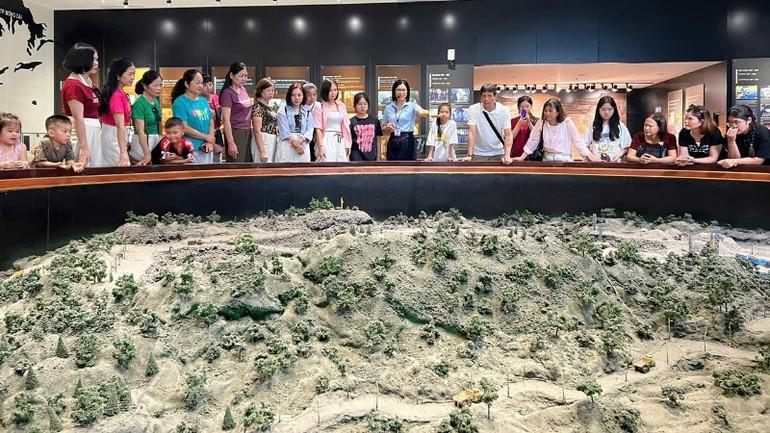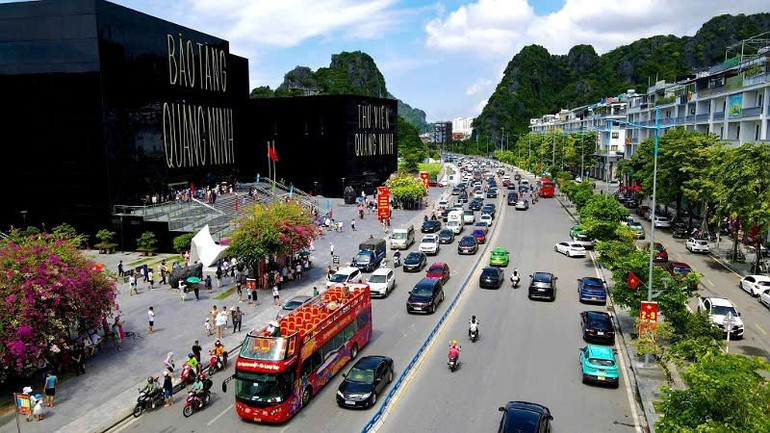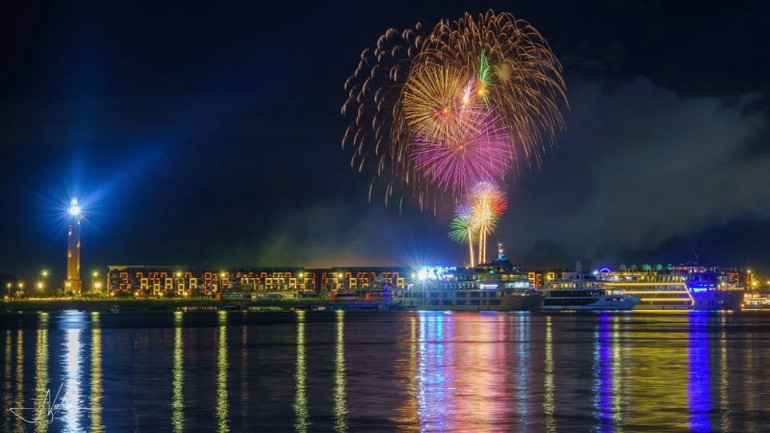
New experiences
On the occasion of the recent National Day, in the "Tran Dynasty" space at the Quang Ninh Museum, Mr. Mai Huy Duc ( Hanoi ) took the opportunity to bring his whole family to visit and try on the automatic commentary headset.
After a few minutes of listening, he shared: “Before, when I went to the museum, I often just looked at the exhibits and read the short information written on the outside of the glass case. Now, listening to the clear and easy-to-understand voice, I feel like I understand more deeply about the history, culture, people, and land I visit, not as dry as before.”
For many Vietnamese tourists, it was the first time they had encountered a form of introduction using modern technology in a traditional exhibition space.
Not only domestic visitors, many foreign tourists to Quang Ninh also expressed their interest in trying to scan the QR code at Tra Co communal house or Xa Tac temple. With just a simple operation, they can access the explanation content in English, Korean, Chinese, etc.
A foreign tourist commented: “What I like most is the convenience. No need for anyone to translate, the information appears right on the phone, both fast and intuitive.”

During the field trip of a group of high school students in Hanoi, the excitement was also evident. They said that listening to the explanations and illustrations made the tour like a “history lesson with technology”, easier to remember and much more vivid.
Thanks to the multilingual explanation application, seemingly quiet artifacts – from the Ngoa Van Gold Box to the Thai Lang Tower – become closer and more alive. Therefore, it is no coincidence that Quang Ninh Museum welcomes 750,000-800,000 visitors each year.
Mr. Do Quyet Tien, Director of Quang Ninh Museum, said that in the coming time, the unit will coordinate with related units to continue adjusting the exhibition space, applying digital technology solutions to help visitors have more interesting experiences and discoveries...
Technology is not only present in museums, but also in many other destinations. In Ha Long Bay, electronic ticketing software helps reduce crowding; at Yen Tu, electronic tickets have replaced traditional ticketing, saving time and providing tighter management. In Ha Long, a smart cruise ship management system is being tested to regulate routes and reduce congestion during rush hours.
These applications have opened up a new way of doing things: bringing technology into tourism life, to make tourists' journeys more convenient, modern and full of experiences.
Synchronous initial step
Assessing the initial changes in the digitalization journey, Mr. Nguyen Lam Nguyen, Deputy Director of the Department of Culture, Sports and Tourism of Quang Ninh province, said that the province has proactively laid a solid foundation from the data stage, the factor considered the "brain" of smart tourism.
The province has built and put into operation four important databases including: accommodation system, travel agencies, tour guides and network of tourist areas and spots. This is not just a collection of discrete information, but has been standardized and regularly updated, helping management agencies monitor operations, businesses more conveniently connect with partners; while tourists can easily access official and transparent information sources.
Not stopping there, the Department has proposed adding two new data segments: visitor statistics and tourism product statistics. These two pieces are expected to complete the real-time management system, accurately reflecting market supply and demand, thereby making timely decisions.

Along with data, many modern technology applications have been deployed. The province has put heritage management software into testing to increase transparency in operations; encouraged the application of virtual reality (VR) and augmented reality (AR) in introducing and promoting heritage to enhance the experience, especially for young and international visitors.
The electronic ticket system at Yen Tu, Quang Ninh Museum and is expanding in Ha Long is considered an important step forward, not only saving time but also better controlling the number of visitors, preventing loss of revenue.
Along with that, human resource training and development is emphasized. Mr. Nguyen Nghia, a tour guide at a travel company in Ha Long shared: “Previously, managing tourist groups was very manual, sometimes confusing and slow. Since being trained, I know how to use software to update information, interact online with customers, everything is faster and more professional.”
These specific stories show that technology is not just a slogan but has actually entered the daily work of tourism workers.
Another notable step forward is the overcoming of the “wave depression” in Ha Long-Bai Tu Long Bay, which used to cause difficulties for both tourists and businesses. Thanks to the cooperation of major network operators, the entire area is now covered by telecommunications, creating the premise for the synchronous deployment of digital services such as ticket booking, online guidance, and safety warnings right on the bay.
At the same time, the province is also coordinating to build a smart tourist boat management system. Instead of manual coordination, the system will automatically monitor traffic, regulate routes, and allocate boats according to peak hours. This solution is expected to help reduce congestion and ensure safety.
All these efforts show that Quang Ninh is taking the first steps to create a civilized and modern tourism environment.
Bottlenecks and solutions on the digital journey
Despite initial achievements, the journey to digitize tourism in Quang Ninh still faces many significant challenges. With a vast area, both high mountains and offshore islands, telecommunications and technology infrastructure has not been able to cover all areas, creating gaps in digital connectivity.
In many island communes, Internet access remains intermittent, making the implementation of applications such as online ticket booking, automated commentary, or safety warnings incomplete.

Not only infrastructure, the human factor is also a barrier. Thousands of small accommodations and family guesthouses managed by the elderly are still operated manually, with little access to technology.
A homestay owner in Binh Lieu admitted: “I hear about digital transformation, but I’m not even good at using a smartphone, let alone software or applications.” Meanwhile, small and medium-sized enterprises, the majority of the province’s tourism industry, face difficulties in capital and lack of resources to invest in equipment and train human resources.
Some key projects, which were expected to create a boost, such as the Ha Long smart tourism city project, have been slow to implement due to administrative procedures and mechanisms.
Representatives of the leaders of the culture-sports-tourism sector frankly acknowledged: Digital transformation has created clear changes, but cannot be considered a decisive factor for Quang Ninh tourism. That shows that Quang Ninh needs a synchronous infrastructure, drastic implementation and mobilization of the participation of the whole society.
To overcome challenges and achieve the goal of becoming a smart, international-class tourism center, Quang Ninh has identified a comprehensive solution system, connecting from the provincial to the grassroots level, from management agencies to businesses and the community.
According to Mr. Nguyen Lam Nguyen, Deputy Director of the Department of Culture, Sports and Tourism of Quang Ninh province, the province considers the completion of digital data as a key step. The four existing databases, accommodation, travel, tour guides, and tourist areas, will be standardized and connected, while statistics on visitors and tourism products will be added.
When operating in real time, it will become a “hub” to help manage the industry with digital evidence, while providing transparent and authentic information to tourists and businesses.
At the same time, Quang Ninh focuses on applying modern technology. The electronic ticket system will be expanded from Yen Tu, Quang Ninh Museum to other key tourist destinations; relic management software and VR/AR applications will help introduce heritage in a more vivid way.
The province also promotes the deployment of AI chatbots and big data analysis to forecast market trends and personalize tourist experiences.
Regarding infrastructure, Quang Ninh will ensure comprehensive telecommunications coverage. Another pillar is improving the quality of human resources. In the coming period, the province will continue to expand training, coordinate with educational institutions, and encourage businesses to build a "re-skilling" roadmap for staff and tour guides.
More importantly, Quang Ninh emphasizes the mechanism of mobilizing socialization and public-private partnership (PPP). The State will play a role in creating and establishing a legal framework, data platform and digital infrastructure, while technology and travel businesses will participate in developing applications and digital products.
People are both beneficiaries and direct participants, from selling OCOP services and products to promoting destinations via social networks.
In addition, the province also focuses on regional and international connectivity. Action plans emphasize promoting the image of Quang Ninh at international fairs and forums, expanding cooperation with Japan, Korea, Guangxi (China)... The Hanoi-Hai Phong-Quang Ninh triangle continues to be promoted, connecting transport infrastructure (highway, Van Don airport, international cruise port) with a comprehensive smart tourism system.
It can be seen that the solution that Quang Ninh is implementing does not stop at a few separate applications, but is a synchronous strategy: data-technology-infrastructure-human resources-policy. All aim at the common goal of bringing technology deeply into every experience, so that tourism is not only crowded, but also truly high-quality, civilized and sustainable.
Source: https://nhandan.vn/du-lich-quang-ninh-tren-hanh-trinh-so-hoa-post907232.html




![[Photo] General Secretary To Lam attends the National Conference to disseminate and implement 4 Resolutions of the Politburo](https://vphoto.vietnam.vn/thumb/1200x675/vietnam/resource/IMAGE/2025/9/16/70c6a8ceb60a4f72a0cacf436c1a6b54)
![[Photo] Prime Minister Pham Minh Chinh attends the closing ceremony of the exhibition of national achievements "80 years of the journey of Independence - Freedom - Happiness"](https://vphoto.vietnam.vn/thumb/1200x675/vietnam/resource/IMAGE/2025/9/15/a1615e5ee94c49189837fdf1843cfd11)

![[Photo] General Secretary To Lam chaired a working session with the Standing Committee of the Party Committee of the Ministry of Foreign Affairs](https://vphoto.vietnam.vn/thumb/1200x675/vietnam/resource/IMAGE/2025/9/15/f26e945b18984e8a99ef82e5ac7b5e7d)














![[Photo] National conference to disseminate and implement 4 Resolutions of the Politburo](https://vphoto.vietnam.vn/thumb/402x226/vietnam/resource/IMAGE/2025/9/16/5996b8d8466e41558c7abaa7a749f0e6)





![[Video] Closing Ceremony of the National Achievement Exhibition on the Evening of September 15, 2025](https://vphoto.vietnam.vn/thumb/1200x675/vietnam/resource/IMAGE/2025/9/15/a85c829960f340789cb947f8b5709fa8)

































































Comment (0)